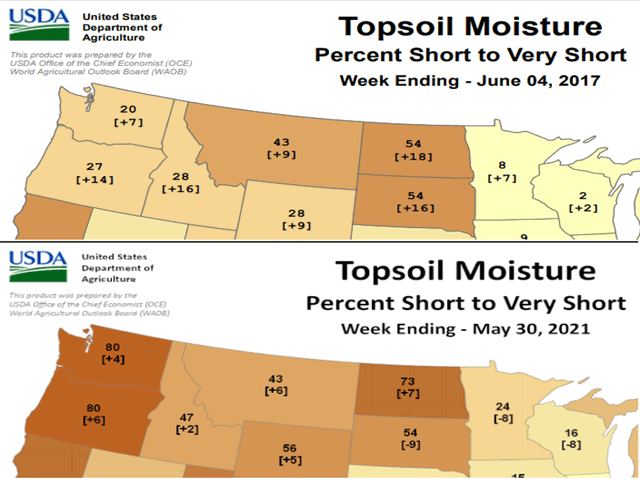Todd's Take
Critical Time for Spring Wheat
Three years and 11 months ago, Todd's Take ran the title, "When Prices Go Vertical," describing the rapid ascent of Minneapolis wheat prices in the face of drought (see https://www.dtnpf.com/…).
Much like today, spring wheat areas were extremely dry at that time and prices were rapidly rising. On July 5, 2017, the day the column appeared, September Minneapolis wheat traded at its highest level of the move, peaking at $8.68 1/2.
I explained that wheat in general was not scarce. The world wheat ending stocks-to-use ratio for the previous season of 2016-17 was 35% at the time, the highest in 15 years. U.S. wheat production is a small percentage of world production and even after the drought of 2017, the world ending stocks-to-use ratio stayed high at 38%.
I mention that because we're in a similar situation today. USDA's estimate of world ending wheat stocks in 2020-21 represents 38% of annual use. There is a difference, though, in USDA's estimate of U.S. hard red spring (HRS) wheat stocks. In May 2017, USDA estimated U.S. HRS wheat ending stocks at 35% of annual use versus 45% in today's situation.
When USDA introduced its 2017 estimate for the new crop in July, the new HRS ending stocks-to-use ratio dropped to 22%, making allowance for the drought-afflicted crop. By the end of the 2017-18 season, U.S. HRS wheat ending stocks finished at 40% of annual use, not as bullish as first thought.
My parting advice in the July 5 column was, "I cannot guarantee spring wheat prices won't go higher, but I can point out several years when selling opportunities this good didn't last long." Little did I know prices would peak that same day.
P[L1] D[0x0] M[300x250] OOP[F] ADUNIT[] T[]
With September Minneapolis wheat resting at $7.82 3/4 on Thursday's close, June 3, 2021, I'm tempted to repeat the same advice, but there are some important differences this time around to keep in mind.
One of the most important differences is that the terrain for spring wheat looks drier this time around than it was in 2017. USDA's weekly weather bulletin for May 30, 2021, showed 73% of topsoil moisture in North Dakota rated short or very short versus 54% at the similar time in 2017. North Dakota accounted for 47% of U.S. spring wheat production in 2020.
Topsoil in 2021 also measured drier in four of the five remaining top spring wheat states versus 2017. Montana was the same at 43% short or very short. USDA's good-to-excellent spring wheat rating of 43% for May 30, 2021, was much lower than the 62% USDA awarded on May 28, 2017.
Another important difference between now and 2017 is that corn prices are much higher today, an important factor of support for spring wheat prices we can't overlook. On June 2, 2017, July corn settled at $3.72 3/4 versus a June 2 close of $6.83 3/4 for July corn this year.
Weather, of course, is the king of factors for wheat. What happens from here forward will make a big difference and may or may not compare to 2017. At this point, DTN's seven-day forecast leans bullish with triple-digit temperatures expected in the Dakotas the next two days. There are increased chances for rain in the western Canadian Prairies next week that could help keep a lid on prices.
Technically, the long-term chart of September Minneapolis wheat prices has not seen sustained trading above $8.00 since early 2013, but with conditions as dry as they are, and corn prices as high as they are, prices do have a chance to trade above the old resistance level.
Unfortunately, for spring wheat producers suffering losses to drought, there is not much to take advantage of in terms of risk management. It is too dangerous to forward price a crop you may not harvest.
For any people fortunate enough to already be holding spring wheat to sell, this is a good time to consider entering limit orders. I understand no one wants to miss out if prices go higher -- and spring wheat prices certainly have that potential -- but you also don't want to watch prices jump to your targets and not have orders placed. I don't know if the crystal ball has rain in the distant future or not, but sometimes it can turn cloudy when you least expect.
For more on spring wheat, consider checking out Mary Kennedy's Cash Market Moves column from Tuesday, June 1, which can be found here: https://www.dtnpf.com/…
**
Comments above are for educational purposes only and are not meant as specific trade recommendations. The buying and selling of grain or grain futures or options involve substantial risk and are not suitable for everyone.
Todd Hultman can be reached at Todd.Hultman@dtn.com
Follow him on Twitter @ToddHultman1
(c) Copyright 2021 DTN, LLC. All rights reserved.




